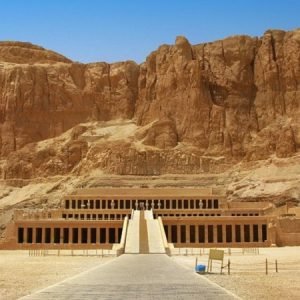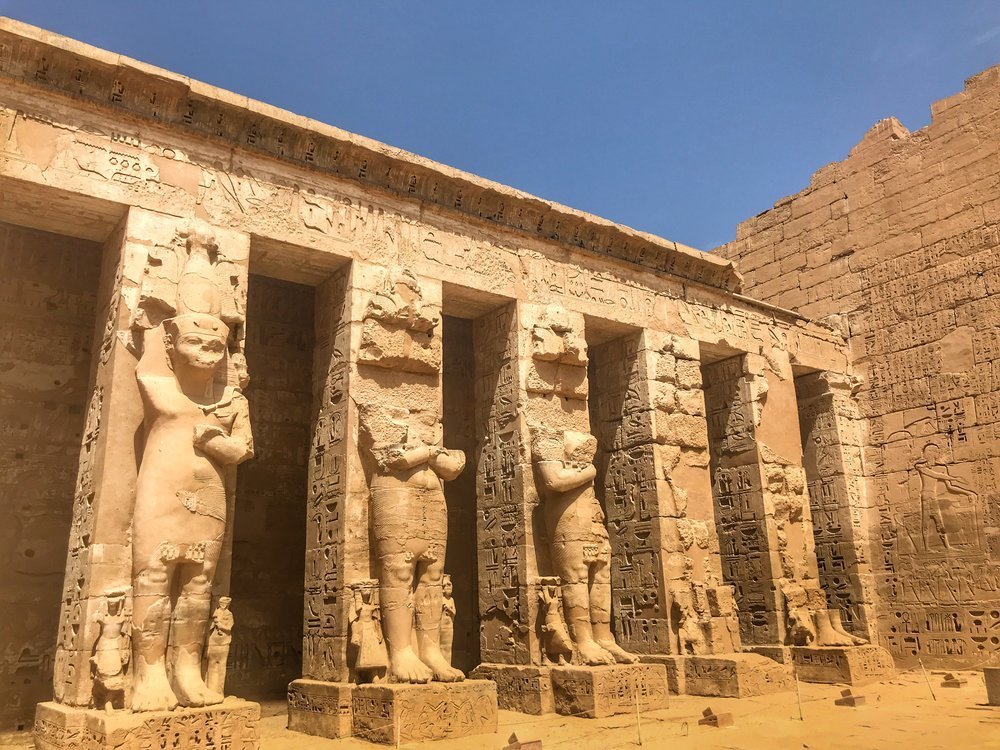Safaga Port serves as an excellent starting point for exploring the wonders of Egypt.
Safaga Port
For history buffs, Luxor is an absolute must with its iconic temples of Karnak and Luxor, and the mysterious Valley of the Kings from Safaga Port.
If you prefer a blend of relaxation and adventure, the Red Sea coast offers pristine beaches, vibrant coral reefs perfect for snorkeling and diving, and charming coastal towns.
For those seeking a unique experience, the desert offers thrilling safaris, encounters with Bedouin culture, and the opportunity to witness breathtaking sunsets.
Uncover Egypt’s Treasures: Luxor, the Red Sea, and Beyond
1-Luxor: A Journey Through Time
Luxor, often dubbed the “World’s Greatest Open-Air Museum,” is a must-visit for history enthusiasts.
Karnak Temple
Karnak Temple stands as one of the grandest religious sites ever constructed, dedicated to the mighty god Amun-Ra. This immense complex, known for its monumental scale, features towering pylons that lead to the majestic hypostyle hall—a vast expanse filled with a dense forest of intricately carved columns.
The site also boasts a serene sacred lake, adding to its grandeur and spiritual ambiance.

Historically, Karnak Temple was believed to be the very site where creation commenced, serving as a divine connection point between the god Amun-Ra and the ancient Egyptians. Its significance extends beyond its architectural splendor; it was a central place of worship and a repository of invaluable insights into ancient Egyptian religion and culture. The temple’s elaborate decorations and inscriptions provide a profound glimpse into the spiritual and ceremonial practices of one of history’s greatest civilizations.
Luxor Temple
Luxor Temple, originally linked to Karnak Temple by a grand, sphinx-lined avenue, is a breathtaking example of ancient Egyptian religious architecture. Dedicated to the powerful deities Amun-Ra and his wife Mut, the temple is renowned for its awe-inspiring features, including towering pylons, a majestic obelisk, and beautifully preserved colonnades. Each of these elements contributes to the temple’s impressive and majestic atmosphere, making it an essential destination for anyone exploring Luxor.
Historically known as Ipet-resyt, or the “Southern Sanctuary,” Luxor Temple is located about three kilometers south of the Karnak Temple complex. This temple was a focal point for the Opet Festival, a major religious celebration in ancient Egypt, which honored the gods and rejuvenated the divine kingship.
The construction of Luxor Temple was a collaborative effort among several prominent pharaohs, including Hatshepsut, Amenhotep III, Tutankhamun, Horemheb, and Ramesses II. Each ruler added their unique contributions, resulting in a temple that stands as a monument to Egypt’s rich religious and cultural history.
The elaborate carvings and majestic scale of Luxor Temple offer a fascinating window into the ancient world, revealing the grandeur and depth of Egyptian civilization.
Temple of Hatshepsut
Located at Deir el-Bahari, this temple is a masterpiece of architecture, carved into the cliffs with terraces and colonnades. It was dedicated to the female pharaoh Hatshepsut and is a testament to her power and influence.

Hatshepsut (c.1473-1458 BC) constructed a magnificent temple in Deir al-Bahari, across the Nile from Karnak Temple. Senenmut designed the temple, known as Djeser-djeseru, or “the Holy of Holies.”The upper level includes an open courtyard with mummiform statues of Hatshepsut as Osiris. The temple is Hatshepsut’s mortuary temple, but it also has sections dedicated to her father Thutmose I, the goddess Hathor, and the funerary god Anubis.
Medinet Habu
Medinet Habu is an impressive ancient Egyptian temple complex located on the west bank of the Nile, close to Luxor.
Renowned for its remarkable state of preservation, this site dates back to the New Kingdom period, offering a glimpse into the architectural and artistic achievements of ancient Egypt.
The centerpiece of Medinet Habu is the Mortuary Temple of Ramesses III, a grand structure celebrated for its intricate carvings, monumental statues, and detailed reliefs. The temple stands as a testament to the grandeur and religious significance of the era, showcasing the artistic prowess and ceremonial practices of the time.
-

Medinet Habu Mortuary Temple of Ramesses III:
-The grand temple was built by Pharaoh Ramesses III, who ruled from 1186 to 1155 BC. It’s dedicated to Amun, the king of the gods, and also served as a mortuary temple for the pharaoh. The walls are adorned with detailed reliefs and inscriptions depicting the pharaoh’s military victories, religious rituals, and offerings to the gods, including battles against the Sea Peoples and other foreign invaders.
-
Chapel of Amun and Other Shrines:
– In addition to the main temple, the complex includes a small temple dedicated to Amun, built by Hatshepsut and Thutmose III. There are also shrines dedicated to various deities and royal ancestors.
5-The Ramesseum
The Ramesseum is a very old and big temple. It was built for a famous king of Egypt named Ramses II. Even though it is broken in many parts, it is still very cool to see.
There used to be a really big statue of King Ramses II there, but now it’s in pieces. You can still see some of it. The temple also has a big room with tall pillars, but it is damaged. There are lots of pictures and writing on the walls that tell stories about the king and the gods.
Even though the Ramesseum is not as pretty as other temples, it is still very important because it shows us how powerful King Ramses II was.
6-The Colossi of Memnon: Two Giant Statues
The Colossi of Memnon are two incredibly big statues of a powerful Egyptian king named Amenhotep III. They are sitting down and look very impressive.
These statues are all that’s left of a huge temple. You can see the statues from far away, and they look even bigger when you get close. They are made of special stones and are very heavy.
People used to say that one of the statues made a sound like a person singing in the morning. This is not true anymore, but it’s still a famous story.
Visiting the Colossi of Memnon is like stepping back in time and imagining how amazing the whole temple must have looked.
Valley of the Kings: Discover the tombs of pharaohs, including the famous tomb of Tutankhamun, adorned with stunning wall paintings and artifacts.
Medinet Habu: Medinet Habu is an ancient Egyptian temple complex on the west bank of the Nile, near Luxor. It is well-preserved and dates back to the New Kingdom period. The main feature is the Mortuary Temple of Ramesses III.
The Ramesseum
The Ramesseum is a very old and big temple. It was built for a famous king of Egypt named Ramses II. Even though it is broken in many parts, it is still very cool to see.
There used to be a really big statue of King Ramses II there, but now it’s in pieces. You can still see some of it. The temple also has a big room with tall pillars, but it is damaged. There are lots of pictures and writing on the walls that tell stories about the king and the gods.
2-The Red Sea: A Coastal Paradise
The Red Sea coast offers a perfect blend of relaxation and adventure:
Pristine Beaches
Unwind on the soft sands, soak up the sun, and enjoy the refreshing waters.
Vibrant Coral Reefs
Discover a breathtaking underwater world teeming with colorful fish and marine life.
Water Sports
Experience the thrill of windsurfing, kitesurfing, or diving in the crystal-clear waters.
Island Hopping
Explore secluded islands, offering tranquility and stunning natural beauty.
3-Cairo: The Heart of Egypt
For a deeper dive into Egyptian history and culture, Cairo is a must-visit:
Giza Pyramids
Witness the iconic Pyramids of Giza, one of the Seven Wonders of the Ancient World.
Egyptian Museum
Explore a vast collection of artifacts, including treasures from Tutankhamun’s tomb.
Islamic Cairo
Immerse yourself in the city’s rich Islamic heritage with its historic mosques and bustling souks.
Egyptian Museum
Delve into Egypt’s rich history at this treasure trove of artifacts. Explore the vast collection, including the stunning golden treasures of Tutankhamun.
Khan el-Khalili Bazaar
Immerse yourself in the vibrant atmosphere of Cairo’s most famous market. Wander through the narrow alleyways, haggle for souvenirs, and savor the local cuisine.
The Grand Egyptian Museum
A Monument to Ancient Egypt

Prepare to be awestruck as you step into the Grand Egyptian Museum (GEM), a monumental tribute to one of history’s greatest civilizations. This architectural marvel houses a treasure trove of over 100,000 artifacts, offering an unparalleled journey through time.
The centerpiece of the GEM is the Tutankhamun Gallery, where the complete collection of the young pharaoh’s treasures is displayed in all its splendor.
Beyond Tutankhamun, the museum boasts an extensive collection spanning millennia of Egyptian history. Marvel at colossal statues, intricate jewelry, and everyday objects that paint a vivid picture of ancient Egyptian life.
The National Museum of Egyptian Civilization: A Journey Through Time
Discover the heart of ancient Egypt at the National Museum of Egyptian Civilization. Immerse yourself in a world of pharaohs, mummies, and treasures. Explore interactive exhibits, marvel at the grandeur of royal mummies, and witness the evolution of Egyptian culture. It’s more than a museum; it’s an unforgettable experience.
Nile River Cruise: Enjoy a relaxing dinner cruise on the Nile, taking in the city’s skyline and the serene river ambiance.
Coptic Cairo: Discover the ancient Christian heritage of Egypt with visits to Coptic churches and monasteries.
Safaga Port serves as a gateway to a diverse range of captivating destinations, each offering unique experiences that highlight the rich tapestry of Egypt’s cultural and natural heritage. From this bustling port, travelers can embark on a journey to explore the enchanting landscapes and historical treasures of the region.
In nearby Hurghada, visitors can immerse themselves in vibrant marine life through world-class snorkeling and diving excursions, or unwind with leisurely beach days and luxurious resort stays. The city’s lively atmosphere and array of water sports make it a popular choice for relaxation and adventure alike.
A short drive from Safaga, the desert landscapes offer exhilarating experiences such as quad biking and camel riding, providing a thrilling contrast to the coastal environment. The serene beauty of the desert at sunset adds a touch of magic to these adventures.
For those interested in exploring ancient Egyptian history, the temples of Luxor, including Karnak and Luxor Temple, are within reach. These monumental sites, with their grand architecture and intricate carvings, offer a profound glimpse into the grandeur of ancient Egyptian civilization.
Additionally, Aswan’s remarkable temples, such as the Temple of Philae and the awe-inspiring Abu Simbel, are accessible for those seeking to delve deeper into Egypt’s rich historical and cultural legacy.
Each destination accessible from Safaga Port presents a unique opportunity to experience Egypt’s diverse offerings, from its vibrant marine environments and thrilling desert adventures to its awe-inspiring historical landmarks. A visit to these destinations ensures a journey filled with discovery, excitement, and unforgettable memories.
FAQ
What types of shore excursions are available from all ports ( Safaga Port )
- Luxor Day Trip
– Valley of the Kings: Explore the tombs of ancient Egyptian pharaohs, including the famous tomb of Tutankhamun.
– Karnak Temple: One of the largest temple complexes in the world, with its massive columns and intricate carvings.
– Luxor Temple: A stunningly preserved temple located in the heart of the city.
– Valley of the Queens
This area is where the wives of pharaohs and some royal children were buried. The most famous tomb here is that of Queen Nefertari, the wife of Ramses II, which is renowned for its beautiful and well-preserved wall paintings.
– Temple of Hatshepsut (Deir el-Bahari)
his stunning terraced temple was built by Queen Hatshepsut, one of Egypt’s few female pharaohs. The temple is dedicated to the god Amun and reflects Hatshepsut’s claim to the throne and her achievements.
– Colossi of Memnon
These two massive stone statues represent Pharaoh Amenhotep III and are all that remain of his once vast mortuary temple. The statues stand at the entrance to what was once a grand complex and are a popular photo stop for visitors.
– Medinet Habu (Mortuary Temple of Ramses III)
Well-Preserved Temple: This is one of the best-preserved temples on the West Bank. It was built by Ramses III and is decorated with detailed reliefs depicting his military victories and religious scenes.
– Deir el-Medina (Workers’ Village)
Deir el-Medina was home to the workers and artisans who built the tombs in the Valley of the Kings and other nearby sites. The village provides insight into the daily lives of these workers, and the tombs they built for themselves are small but beautifully decorated.
– Ramesseum
This grand temple was built by Ramses II and was dedicated to the god Amun. The Ramesseum is famous for its giant fallen statue of Ramses II and the extensive reliefs that adorn its walls, depicting scenes of his reign.
– Tombs of the Nobles
These tombs belong to high officials and nobles who served the pharaohs. They are smaller than the royal tombs but often feature detailed and colorful wall paintings that depict everyday life, making them unique and informative.
– The Temple of Seti I
This temple is dedicated to Seti I, the father of Ramses II. It features a series of chapels dedicated to various gods, and its reliefs are among the finest in Egypt.
- Desert Safari
– Quad Biking : Experience the thrill of riding across the desert dunes, with options for sunrise or sunset trips.
– Camel Riding: Enjoy a traditional desert experience by riding camels through the scenic landscapes.
– Bedouin Village Visit: Learn about the local culture and lifestyle of the Bedouin people, often combined with a traditional meal and entertainment.
3.Hurghada Day Trip
– Marina and Beaches: Relax on the beautiful beaches or explore the lively marina area with its shops and restaurants.
– Desert Jeep Safari: An adventurous way to explore the desert, often combined with a visit to a Bedouin camp.
– Aquarium and Dolphinarium: Great for families, offering a chance to see marine life up close without getting wet.
4.Dendera and Abydos Temples
– Dendera Temple: A well-preserved temple complex dedicated to the goddess Hathor, featuring beautifully carved ceilings and columns.
– Abydos Temple: Known for the Temple of Seti I, this site is rich in history and mythology, with detailed reliefs and hieroglyphics.
5.Wadi El Gemal National Park
– Nature Reserve: Explore the diverse ecosystems of this park, which includes desert, mountains, and the Red Sea coastline.
– Mangroves and Wildlife: Ideal for birdwatching and spotting wildlife like gazelles and camels.
– Ancient Mining Sites: Visit ancient Roman emerald mines and other historical sites within the park.
6.El Quseir
– Historic Town: Explore the old town with its Ottoman fort, traditional markets, and ancient mosques.
– Snorkeling and Diving: The waters around El Quseir are less crowded and offer pristine diving and snorkeling spots.
How can I book a shore excursion from Safaga Port ?
Booking a shore excursion from Safaga Port can be an exciting way to explore nearby attractions, such as Luxor or the Red Sea.
Choose Your Booking Method as you prefer.
- Through Your ships Line: Many ships lines offer organized shore excursions that can be booked directly through them. This is convenient and ensures you get back to the ship on time.
- Many Local Tour Operators offer organized land trips that can be booked directly through them. They also offer affordable prices and provide highly experienced guides. This is convenient as you can book in advance and often find more variety, as well as guarantees that you will return to the ship on time.
Are the excursions guided from Safaga Port ?
Absolutely! All of our excursions from Safaga Port are guided. We believe that having a knowledgeable and experienced guide enhances your overall experience.
Our guides are experts in their field, whether it’s marine life, history, or desert adventures. They will provide you with fascinating insights, ensure your safety, and create a memorable journey for you.
When embarking on a shore excursion from Safaga Port in Egypt, join our guided tours led by knowledgeable local experts. Our guides will enrich your journey with fascinating stories and hidden gems, ensuring that you make the most of your time while staying safe. Explore breathtaking landscapes, encounter diverse marine life, or uncover the secrets of ancient civilizations with our expert guidance for an authentic and enriching experience.
How many hours needed at Cairo from Safaga Port by car and flight?
Traveling from Safaga Port to Cairo can be done either by car or by flight.
- By Car
– Distance: Approximately 570 km (354 miles).
– Duration: The drive takes around 6 to 7 hours, depending on traffic and road conditions.
- By Flight
– Drive to Hurghada Airport: Safaga is about 60 km (37 miles) from Hurghada Airport, which takes around 1 hour by car.
– Flight Duration: The flight from Hurghada to Cairo takes about 1 hour.
– Time at Airports: Consider an additional 2 to 3 hours for check-in, security, and potential waiting time at both Hurghada and Cairo airports.
What is the Distance Between Safaga Port and Cairo?
The distance between Safaga Port and Cairo is around 570 kilometers (354 miles) by road. The typical drive time for this journey is approximately 6 to 7 hours, depending on factors such as traffic and road conditions.
Alternatively, traveling by air is a faster option. The flight time between Safaga and Cairo is around 1 hour. However, this air travel option also requires an additional hour or so to reach Hurghada Airport, which is where most flights to Cairo depart from.
Which airport is closest to Safaga Port?
The nearest airport to Safaga is Hurghada (HRG) Airport which is 63 km away, 51 minutes
The destination between Safaga Port and Marsa Alam airport is around 1 hour 55 minutes (165.9 km) via Quseir – Marsa Alam Road


Comment (0)